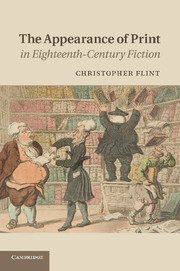Book contents
- Frontmatter
- Contents
- Figures
- Acknowledgments
- Introduction: Prose Fiction and Print Culture in Eighteenth-Century Britain
- Part One Author book reader
- Part Two Reader book author
- Chapter 3 Dark matters: printer’s ornaments and the substitution of text
- Chapter 4 Inanimate fiction: circulating stories in object narratives
- Chapter 5 Only a female pen: women writers and fictions of the page
- Chapter 6 After words
- Notes
- Bibliography
- Index
Chapter 6 - After words
from Part Two - Reader book author
Published online by Cambridge University Press: 07 September 2011
- Frontmatter
- Contents
- Figures
- Acknowledgments
- Introduction: Prose Fiction and Print Culture in Eighteenth-Century Britain
- Part One Author book reader
- Part Two Reader book author
- Chapter 3 Dark matters: printer’s ornaments and the substitution of text
- Chapter 4 Inanimate fiction: circulating stories in object narratives
- Chapter 5 Only a female pen: women writers and fictions of the page
- Chapter 6 After words
- Notes
- Bibliography
- Index
Summary
While the form of the “book” is now going through a period of general upheaval, and while that form now appears less natural, and its history less transparent, than ever, and while one cannot tamper with it without disturbing everything else, the book form alone can no longer settle – here for example – the case of those writing processes which, in practically questioning that form, must also dismantle it.
(Jacques Derrida, Dissemination, 1981)Book’s frighted them terribly.
(Daniel Defoe, A Journal of the Plague Year, 1722)As carpenters, smiths, masons, and all mechanics smell of the trade they labour at, booksellers take a peculiar aura from their connexions with books.
(The Beauties of English Prose, 1772)Anxious that London might experience another plague like the one in 1665, H. F., the quasi-anonymous narrator of Defoe’s A Journal of the Plague Year (1722), opens with an assessment of how print culture could both address and inflame the ills of the metropolis. “We had no such things as printed News Papers in those Days, to spread Rumours and Reports of Things; and to improve them by the Invention of man, as I have liv’d to see practis’d since” (1). H. F.’s comment suggests that Defoe perceived a qualitative difference between the immediate post-Revolutionary circuit of information and early eighteenth-century forms of dissemination. The fifty-seven years between the plague and the appearance of H. F.’s journal had, it would seem, significantly altered the publishing landscape. Although the emphasis on the “printed” nature of “News Papers” may seem slight, it signals a distinction that would disappear when newspaper and print became virtually synonymous. The very stress on “print” indicates a shifting attitude toward typography, and reinforces the implicit parallel between publication and plague that Defoe exploits throughout A Journal.
Starting the conclusion to my book with A Journal of the Plague Year may seem odd, but Defoe’s work dwells, perhaps more than any other eighteenth-century text, on the unpredictability of how book production and distribution intersected with authors’ and readers’ activities in a time of national crisis. Circulated twelve years after the passage of the Act of Anne in the wake of renewed fears of plague, A Journal broods over the perplexing nature of appearing in print. Indeed, H. F. frequently uses the word “publish” and its variants to connote the public airing of information and opinion by concerned citizens, the release of official regulatory documents, and the mechanical reproduction of texts. While at times he seems to commend unimpeded publication of material, at others he cautions against its hazards. Rather than demonstrating only how the fixity, uniformity, trustworthiness, and authority of print were logical and inevitable extensions of letterpress technology, he also posits that early eighteenth-century printed matter was diverse, intricate, and often unreliable. He likewise features aspects of print culture that indicate the disordering impact as much as rationalizing force of the Enlightenment’s publishing revolution. And as a fictional mouthpiece for Defoe’s reconstruction of historical events, H. F. also foreshadows concerns about the role of fiction in shaping public mindedness through increased circulation in print. Defoe’s narrative thus highlights the principal features of print culture that I have been tracing in assorted fictional settings throughout The Appearance of Print. In essence, he offers two accounts of print ideology, a clearly visible binary version in which print is either beneficial or detrimental and a more submerged variant that registers the mobile, interconnected, and rapid forces at work in the eighteenth-century sphere of British publication.
- Type
- Chapter
- Information
- The Appearance of Print in Eighteenth-Century Fiction , pp. 223 - 237Publisher: Cambridge University PressPrint publication year: 2011

